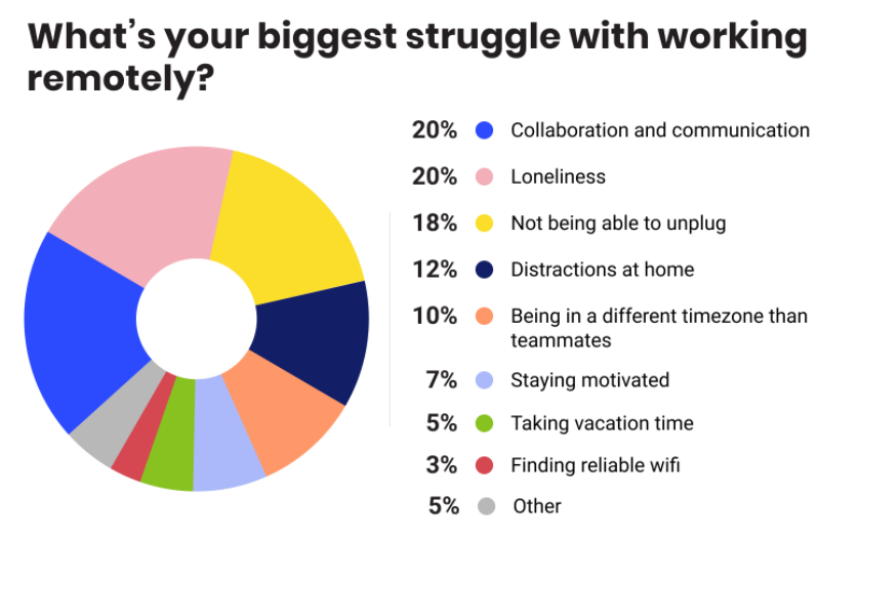Prepared or not, remote work is a reality that organizations need to come to terms with, sooner or later.


Prepared or not, remote work is a reality that organizations need to come to terms with, sooner or later.
According to Harvard Business Review, 115% more people worked remotely in 2019 as compared to 2018. And, given the COVID-19 situation, this number is expected to rise higher going forward.
But why has remote work suddenly become so popular? Because it provides businesses with numerous benefits, such as:
However, not all companies have been able to adapt to the remote work culture so well.
Even mega-brands like Aetna and Yahoo, which are always at the helm of disruptions, have noticed a dip in their workers’ productivity ever since they went remote. These brands were forced to call back their workers to the office so as to maintain productivity levels.
Sound familiar?
Then you are in the right place. In this post, I’m going to discuss five proven strategies to super-charge your remote teams and extract quality work from them.
Let’s get started...
Remote workers face unique challenges - professional, psychosocial, and mental, which hamper their productivity in a big way. Combine that with a lack of supervision and communication gap between ranks, and managers have a big problem on their hands.
The solution?
Follow these remote work hacks and keep your remote teams on their toes:
According to a Buffer survey, 20% of remote workers struggle to collaborate and communicate with their colleagues.

Team members separated by geographies, languages, and time zones, find it hard to collaborate seamlessly with colleagues.
Since managers are not readily available (as with in-office setups), there can be delays in task allocation and knowledge transfers. For people managing large teams, it’s time-consuming to follow-up for status updates. All of this can take a toll on work quality, delivery schedules, and employee motivation levels.
To avoid this issue, managers need to equip their off-site teams with these tools:
Project Management Tools: Tools like JIRA and Trello monitor project progress and team productivity. By using them, managers can get a helicopter view of their pipeline and plan their tasks and resources more efficiently.
Team Collaboration/Communication Tools: Mobile-friendly messaging apps like Skype and Slack keep scattered teams connected anytime and anywhere. Users can share files, set up alerts, and create exclusive user groups for better communication.
Video-Conferencing Platforms: For remote teams, daily meets are a must. On top of that, project meetings, sales calls, and employee orientations are also a staple. To hold virtual meetings at scale, you can use platforms to host webinars, like Zoom and GoToMeeting.
Whether you need to deliver pre-recorded sales pitches or personalized training sessions, webinars and video conferences can help you with the task.
Granted, remote workers have huge challenges to surmount. But managers can push them to give their best by setting expectations right from the beginning.
But how?
In the first virtual meeting itself, convey turn-around times and quality standards that you expect from each team member. Then, track employee performance using free time tracking app like Workday, Namely, and Taleo.
If any of your subordinates are lagging behind in their deliveries or struggling to meet quality requirements, take the time to guide them. You can also devise mentorship programs for employees new to your system.
Encourage your employees to set aside dedicated workspaces, especially for client and team meetings. A distraction-free working environment will help keep them focused and productive.
Even for daily meetings, inject a note of seriousness and purpose. Plan your meetings well by defining clear-cut meeting agendas. Chalk out “rules of engagement” for the attendees. For instance, no pajamas, on-time joining, and maintaining minutes.
To maintain discipline and reduce chaos, set some protocols for your out-of-office employees.
For example, they should inform their managers about time off, early punch-outs, and task delivery glitches. This way, managers are aware of their team’s bandwidth and workload. They can plan task allocations and delivery schedules accordingly.
Remote workers are prone to feelings of isolation and boredom, according to the Buffer survey cited earlier. Prolonged stretches of unhealthy morale can negatively impact their productivity.
Most remote employees work from home, with just a small fraction operating from coffee shops or co-working spaces. These people don’t have a change of scenery and water cooler breaks to brighten up their routines. They miss the camaraderie that in-house teams share.
There’s one more problem that is experienced by hybrid teams (remote + onsite). In such teams, the remote staff often complains that their in-house peers get preferential treatment and better professional opportunities.
When you work with international teams, the communication gap between teams widens. Language barriers are a breeding ground for misunderstandings. So are differences in cultures, races, and geographies.
You may want to consider using translator software for smoother communication with foreign workers. You can also nip the problem in the bud by hiring workers from similar backgrounds. But if that isn’t possible, try to bond your diverse teams by celebrating their festivals and granting leaves for their national holidays.
To cope with emotional issues, counsel your team members. Advise them to keep their minds stimulated and keep boredom at bay. Here are some tips to rejuvenate the mind that you can share with your colleagues:

It’s also a good practice to check-in with your teams on a daily basis. Ask them about task statuses and challenges in task completion. Keep the interactions informal so that everyone feels at ease.
During the course of work, try to understand each employee’s unique strengths and weaknesses. This way, you can assign tasks that align with their skill sets and deliver better results as a team.
Remote workers can be as productive as in-office employees. In fact, equipped with the right tools and mindset, they can deliver even better output.
It’s no wonder that companies like Dell and Gartner went “remote forever” when they noticed a spike in employee productivity. You can replicate their success by following the efficiency-boosting tips in this post.
Do you need more productivity hacks or tools to master remote work? Let me know in the comments. I’m always happy to help my readers.
Shane Barker is a digital marketing consultant for 15 years with an emphasis on Influencer Marketing in the last 5 years. He is specialized in sales funnels, targeted traffic and website conversions. He has consulted with Fortune 500 companies, Influencers with digital products, and a number of A-List celebrities.






